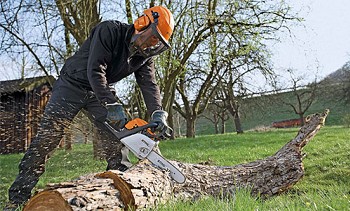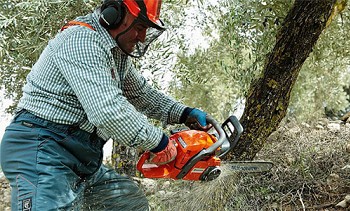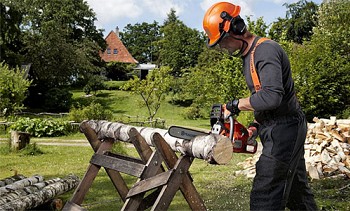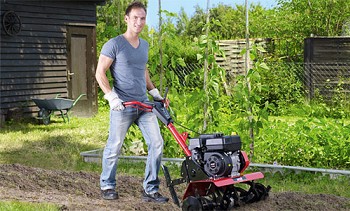How to choose a chainsaw - detailed instructions
The word "chainsaw" for many of us is strongly associated with muscular lumberjacks who pick up a powerful tool and playfully cut thick trees. But a chainsaw can be an indispensable tool for ordinary people who are accustomed to do everything with their own hands, rather than relying on utilities or someone else's help.
To prepare firewood for a house or a bathhouse, to cut lumber for erecting a small outbuilding, cut thick branches from apple trees to form their crown, or to cut down an old tree under a window ... but who else needs those who live and work outside the city. Almost every country owner sooner or later decides to purchase a chainsaw.
What chainsaw to choose for home or garden? What chainsaws generally exist and what is the difference between them? How to choose the right supplies and fuel? Those who buy such equipment for the first time have many similar questions, and without an answer to them it is difficult to make the right choice.
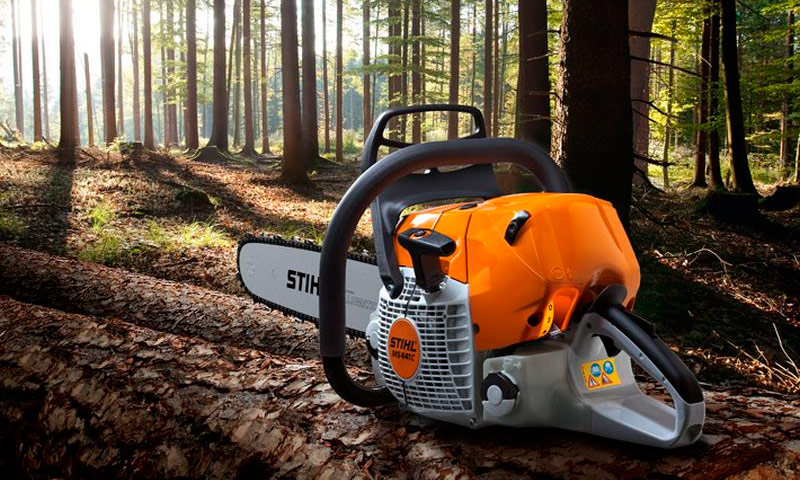
Content:
- The device of the chainsaw and the principle of its operation
- Types of saws: domestic, professional and semi-professional
- Chainsaw engine
- Choosing a Chainsaw Tool
- Additional functions
- What you need to know about gasoline and oils used in the operation of chainsaws
- Chainsaw manufacturers who have established themselves in the market
The device of the chainsaw and the principle of its operation
A chainsaw is a chain saw. This means that its working element is a metal chain closed in a ring with saw teeth fixed to it. During operation, the chain moves along the perimeter of the guide web - the tire.
The chainsaw is driven by a two-stroke internal combustion engine running on a gasoline-oil mixture. The mixture of liquid fuel with air occurs in the carburetor, with its help, the amount of air-fuel mixture supplied to the engine cylinder is regulated.
The engine is started by a manual cord starter. In this case, the crankshaft spins. At one revolution, the spark generated by the spark plug ignites the air-fuel mixture. The gas generated during fuel combustion pushes the piston. The latter is connected via a connecting rod to the crankshaft, which by inertia goes to the second revolution. The engine spins the drive sprocket, which in turn moves the chain.
A chainsaw runs on liquid fuel, which means that one of its structural components is a fuel tank. Manufacturers try not to install too large tanks on the saws, since this would lead to a significant increase in the dimensions of the tool (and in the refilled condition and weight). Most light models for domestic use are equipped with a tank with a volume of 0.2 to 0.5 liters. Powerful professional chainsaws require more fuel, so their tank volume can reach 0.8–1.3 liters. The tank volume determines the duration of non-stop operation for refueling.
Two-stroke engines do not work on pure gasoline, but on a gasoline-oil mixture. The oil that comes with the fuel lubricates the piston group and other “engine interiors”. However, the chainsaw has a separate oil reservoir - it is filled with a sufficiently viscous mineral lubricant designed for the chain and tire.
The chain needs constant lubrication; when operating “dry”, it abrades itself and abrades the tire. The faster the chain rotates, the more it should be lubricated. On the other hand, when the engine is idling and the chain is stationary, it does not need lubrication. That is why the chainsaw chain is lubricated automatically.
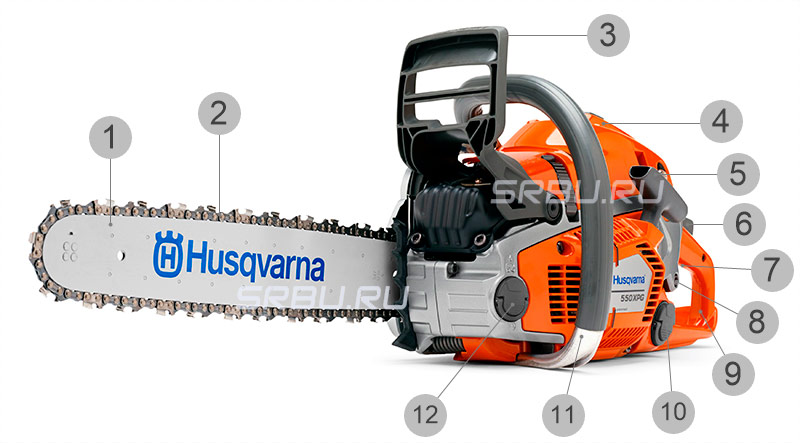
1. The tire.
2. Chain.
3. Inertial chain brake.
4. Cylinder cover.
5. Starter handle
6. Safety trigger.
7. Trigger gas.
8. Throttle Lever.
9. The rear handle.
10. Oil tank cap.
11. Front handle
12. Fuel cap.
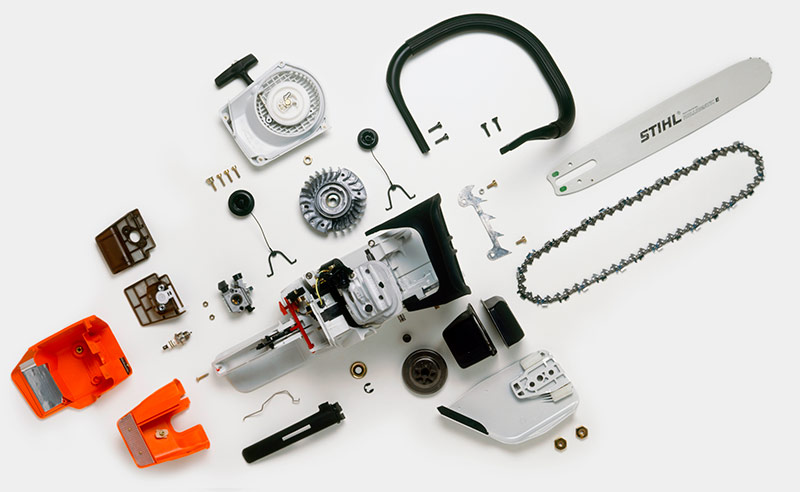
Types of saws: domestic, professional and semi-professional
According to their capabilities and their intended purpose, all chainsaws are divided into domestic, professional and semi-professional (often called farm) - an option between the first two positions. Between themselves, they differ primarily in terms of power and laid resource of work.
Household chainsaws are designed to make firewood for the stove, cut trees on the site, carry out small-scale construction work and other needs of the average resident of a country house. With the help of semi-professional saws, the same types of work are performed, but in a slightly increased volume of farming. Professional chainsaws are designed for work related to logging.
The power of household chainsaws is usually less than 2 kW. This is enough to solve simple everyday tasks. You won’t succeed in felling centuries-old pine trees in the taiga with their help, but they are quite capable of cutting branches from fruit trees on a personal plot. The power of "professionals" is significantly higher - up to 6–9 kW. The cutting speed and the depth to which the tire will penetrate the wood depend on the power of the chainsaw.
Of course, for powerful units there are no tasks that they could not cope with. However, you should not thoughtlessly chase high power. Among those who read this article in order to figure out which chainsaw to choose, there are unlikely to be many professional lumberjacks. For operation in the household, a household or at least semi-professional model will be enough. Indeed, at low power, they have a huge advantage - low weight (up to 5 kg), which makes working with them easy and comfortable.
For comparison: the weight of powerful professional chainsaws can reach 10-15 kg (and for those who cut down the forest, this is not a disadvantage, because the large weight of the tool greatly facilitates the process of sawing large tree trunks), it is not surprising that lumberjacks are people of exceptional physical strength.
It should be taken into account that the actual weight of the chainsaw will be even more, because the weight of the completely filled tanks for fuel and oil and the weight of the saw set will be added to the weight of the tool itself. (To reduce weight, the crankcase and cylinder are made of aluminum or lightweight magnesium alloys, and some household chainsaws even put plastic crankcases, which is less reliable, but easier and cheaper.)
In addition to power, household, semi-professional and professional chainsaws also differ in their resource, i.e. operating time until the compression decreases by 40%, which means that the engine will need major repairs. In this case, not only the total number of hours, but also the time of continuous operation during the day is important.
The resource of household chainsaws is small (usually less than 1000 hours): they are designed to work no more than 20 hours per month (i.e. less than an hour per day). Professional chainsaws are able to work without a break for 8-12 hours or more a day, and in this mode they can work for almost a year.
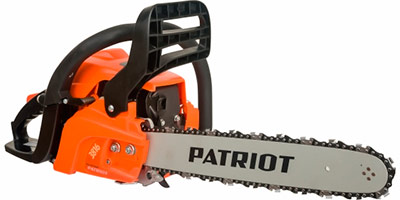 | 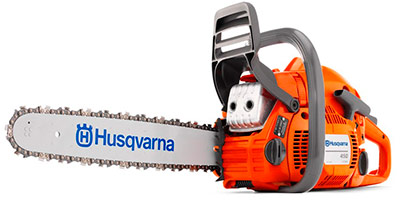 | 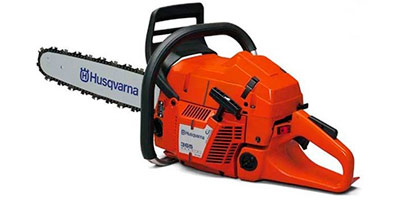 | |||||||
|---|---|---|---|---|---|---|---|---|---|
| Household Chainsaws | Farm Chainsaws | Professional Chainsaws | |||||||
| Engine displacement, cm3 | up to 50 | up to 60 | up to 121 | ||||||
| power, kWt | up to 2 | 2 – 3 | 3 – 9 | ||||||
| Power, l from. | up to 1.5 | 1.5 – 2.2 | 2.2 – 6.6 | ||||||
| Weight | 2 – 5 | 5 – 7 | 10 – 15 | ||||||
| Resource of work, per day | 40 - 60 minutes | 8 - 10 hours (up to 4 hours without stopping) |
10 - 16 hours (up to 8 hours without stopping) |
||||||
| Resource of work, total | 500 - 1000 hours | 1000 - 1500 hours | 1500 - 2000 hours | ||||||
Chainsaw engine
As mentioned above, the chainsaw is powered by a two-stroke engine. The main characteristic of any engine is its power. The engine power of a chainsaw, like any other internal combustion engine, is usually calculated in “horsepower”. However, for the convenience of comparing the characteristics of gasoline and electric saws, this indicator is often indicated in kilowatts (1 hp = 0.735 kW).
Of course, engine power primarily depends on its volume. So, for instruments with an engine capacity of up to 50 cubic centimeters, the power does not exceed 2 kW, and for models with an engine capacity of 90 cubic centimeters it can reach 6 kW.
The larger the displacement, the higher the saw performance. The cutting speed and the suitability of the saw for continuous operation directly depend on power. Let's say you need a chainsaw to make firewood for a bath; you are unlikely to spend more than an hour a day on this job. This means that a saw with a power of 1–1.5 kW is suitable for you. If we are talking about felling trees in the forest, then the chainsaw will be used daily for 8-12 hours. The optimal solution in this case will be a professional model with a capacity of 6 kW or more.
Air filter
The air entering the carburetor must be clean and free of dust. On chainsaws, the air filter is subjected to heavy loads, because in the process, a lot of dust and debris is created, which constantly rushes to the filter. As a result, the filter needs periodic cleaning. It is good if the chainsaw has quick access to the air filter. Without having to disassemble the case using a screwdriver or key.
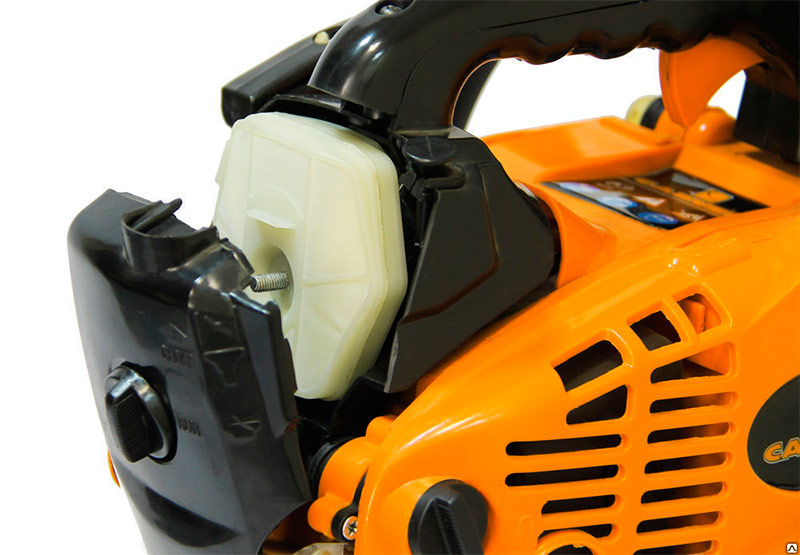
To prevent frequent clogging of the filter, manufacturers use various devices for air pre-treatment. The simplest solution is a grid, which acts as an additional coarse filter. But the most effective solution is a centrifugal cleaning system. Its main assembly is the starter flywheel blades, which, rotating at high speed, discard debris from the air intake.
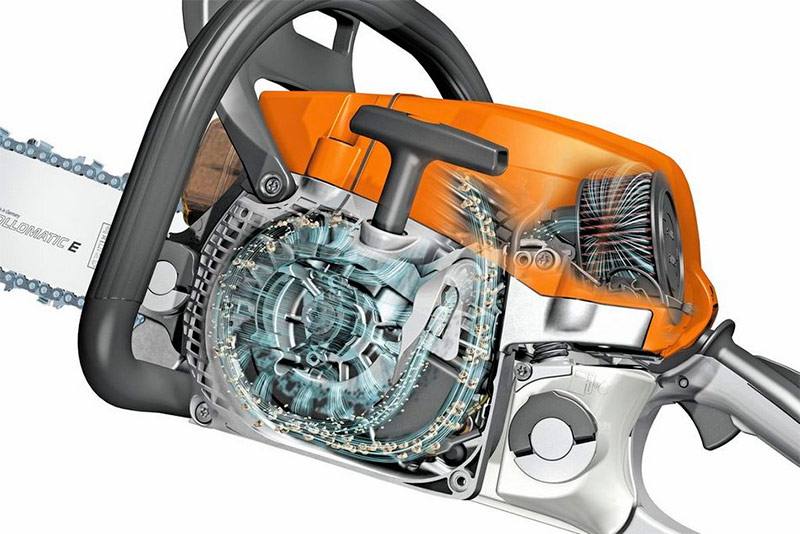
When clogging the filter, the air flow is difficult. This affects the quality of the working mixture of the engine and reduces its power. To solve this problem, some manufacturers complete saws with special carburetors with built-in compensators. Compensators regulate fuel supply depending on the incoming air. This ensures constant engine power despite reduced air flow.
Engine piston system
The number of piston rings. Engine pistons that are mounted on chainsaws can have one or two compression rings. Engines with one ring on the piston, in most cases, are installed on household models. Engines with two rings on the piston are installed on the farm and professional class models.
Engines with two compression rings have greater compression and power. There are some advantages to engines with one compression ring. Such engines have greater throttle response and easier starting. Despite these advantages, it is better to give preference to engines with two compression rings on the piston.
Cylinder-piston group. Pistons and engine cylinders are made of aluminum. Since aluminum is a soft material, the cylinder walls are treated with wear-resistant coatings. Most often, chromium or nicosil is used as such coatings.
Accordingly, the engine life will depend on the thickness of these coatings. Chrome is a more wear resistant material. However, Nicosil provides better oil retention and is able to reach full power faster. In addition, engines with this coating are less afraid of overheating.
Crankshaft
There are two types of crankshafts mounted on chainsaw engines - stamped and forged. Stamped is used on some household chainsaw engines. The forged crankshaft is more durable and all well-known manufacturers use it in their engines.
Engine crankcase
The engine crankcase can be made of aluminum or magnesium alloy, as well as plastic. Plastic crankcases are placed on the engines of household chainsaws and are used to reduce the weight of the chainsaw. Despite the fact that metal sumps are heavier, they are more durable and reliable.
Devices that facilitate starting the engine
It should be taken into account that when starting an engine with a large volume it can be extremely difficult to overcome the resistance of compressible air. First, the fuel is sucked into the carburetor, then into the cylinder ... as a result, by the time the air-fuel mixture could ignite and the engine started, accordingly, there was no longer enough force to pull the starter cord sharply. Therefore, many chainsaws, and especially powerful ones, are equipped with various mechanisms that facilitate starting the engine:
1. Primer - a pump for pumping fuel into the carburetor (allows you to reduce efforts when starting the engine by 50–70%).
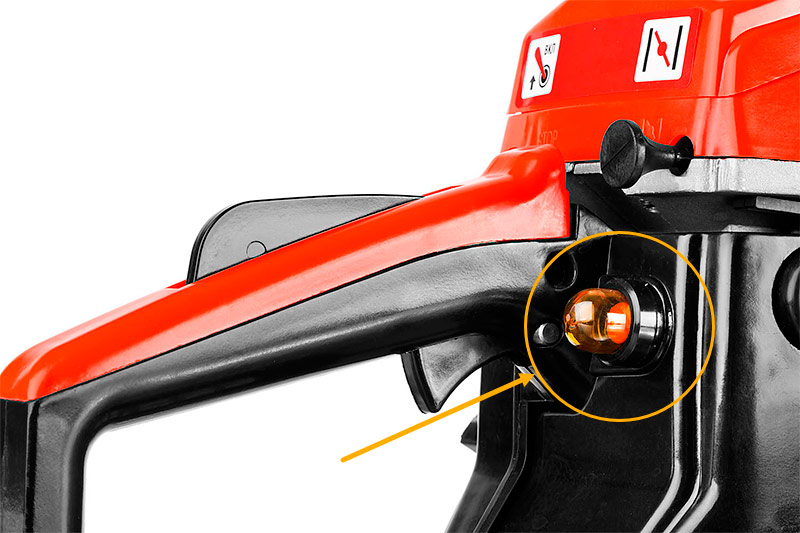
2. Decompression valveconnecting the cylinder with the atmosphere to reduce pressure, which facilitates the "untwisting" of the engine.
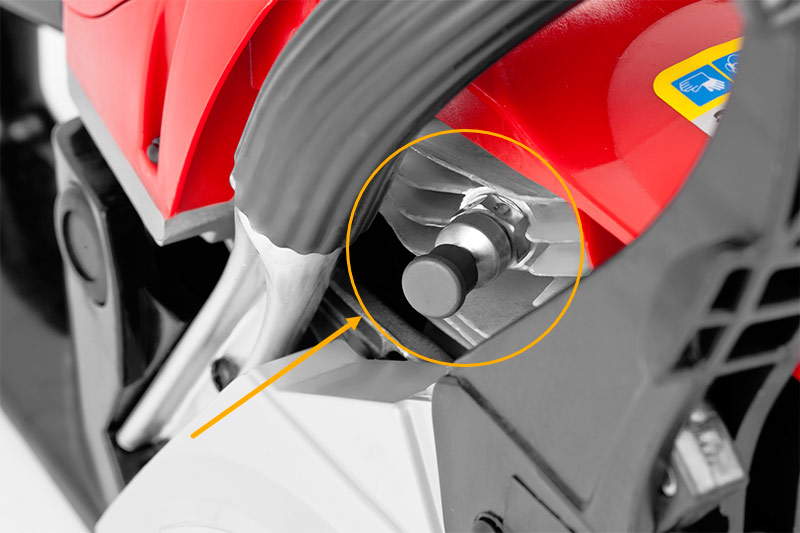
3. Spring starter, which makes it possible to pull the starter cable slowly (at the same time, only the spring is cocked, at some point sharply cranking the crankshaft).
Choosing a Chainsaw Tool
Chainsaw tire
The chainsaw tire is designed to guide the chain. In addition, it serves as a channel for its lubrication. The length of the tire is one of the most important characteristics of the tool, determining its capabilities. The longer the tire, the greater the depth of cut.
For example, a chainsaw with a 40 cm tire is capable of sawing a log 35 cm thick in one go.
However, starting from the choice of the size of the working blade should not be based on your desires, but on the capabilities of the tool, in particular on engine power. Long tires are placed only on powerful professional tools. For household models, the tire length should not exceed 30–40 cm. If you plan to cut branches or thin trees, this is more than enough. And to manage with compact equipment is much easier. For felling thick trees, you will need a chainsaw with a tire of 50-60 cm or more (up to 1 m): less effort and time will be spent on cutting each trunk.
In most cases, manufacturers initially complete their saws with tires and chains suitable for this model. Of course, if you wish, you can buy additional equipment separately. However, it should be remembered that the dimensions of the tire must match the power of the tool.
The longer the tire, the greater the resistance the engine will experience. If you do not adhere to the recommendations specified in the instructions for the tool for the maximum allowable tire length, the load on the engine will increase significantly, and the saw’s life will accordingly decrease. Not only productivity depends on correctly selected equipment, but also the tool service life and worker safety.
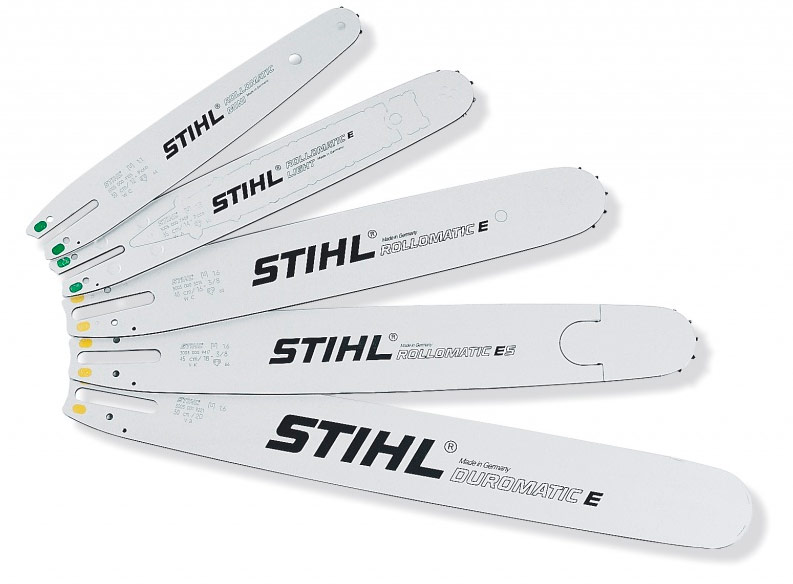
What you need to know about the chainsaw chain
The saw chain consists of individual links fastened with rivets. Chainsaw chains can vary in profile height, tooth thickness and shape, and chain pitch. The last parameter is calculated by halving the distance (expressed in inches) between three consecutive rivets.
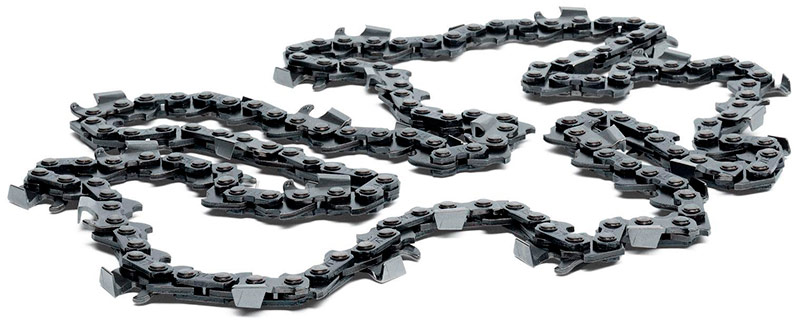
The saw performance depends on the size of the chain pitch. It would seem that it is enough to put a chain with a maximum step on a chainsaw, and your tool will not be equal in the area. However, in practice, such a miracle is observed, alas, extremely rarely. Usually, when installing a chain with too large a pitch, the chainsaw refuses to work. The explanation is extremely simple: a low-power engine is not able to drag the overall chain through the cut. The reverse situation will also negatively affect the operability of the tool. A chain with a small pitch, mounted on a saw with a powerful engine, will slip through the wood, like on ice.
Thus, if you want the saw to retain its functionality, you must remember the rule: it is possible to replace the circuit with another, with a different step, but you can change this parameter in a small range. In general, the circuit should correspond to engine power. For light chainsaw models, a chain with a pitch of 0.325 ″ is recommended, for more powerful ones - 0.375 ″ or even 0.404 ″.It should also be taken into account that the smaller the chain pitch, the less the vibration of the saw will be, which means that such a tool is better suited for everyday use.
There are chains designed specifically for sawing frozen wood. On their teeth there are solid victorious soldering. For ordinary chains, such work is too tough, but a soldered chain quickly dies in soft wood.
Each link of the chain consists of two teeth - cutting and leading. Typically, the cutting tooth is 0.5–0.8 mm higher than the leading. This difference corresponds to the depth of the "incision" of the tooth into the wood.

The chain length must match the length of the tire. However, even an ideally suited initial chain is gradually stretched during operation and requires periodic verification and adjustment of the tension force. The chain is tensioned by tightening a special screw located on the tire.
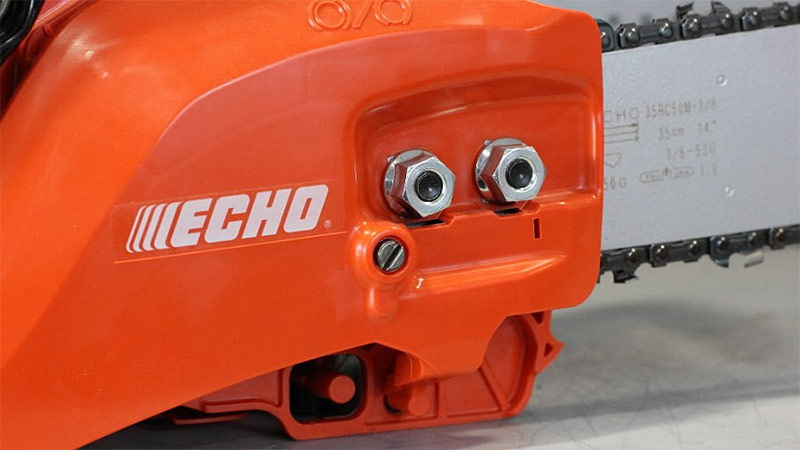
Today, some manufacturers make the tensioner toolless, that is, not requiring a screwdriver or any other special tool.
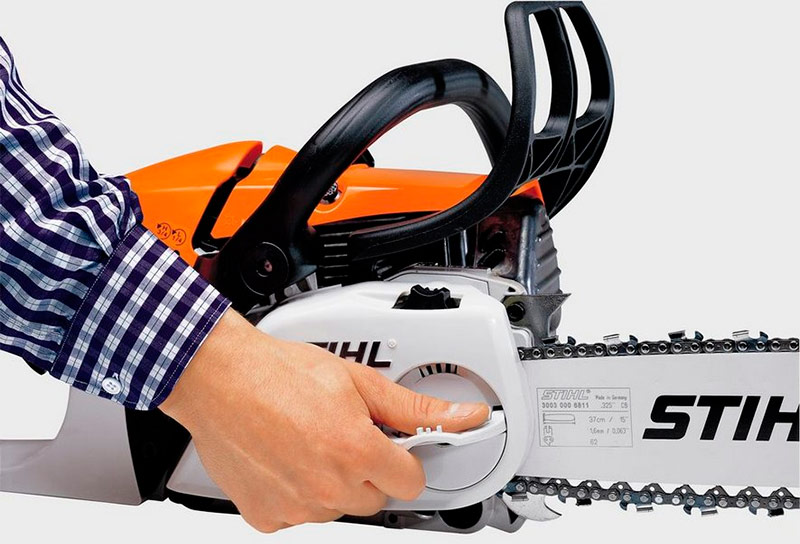
Oil pump
During sawing, the chain moves along the tire and needs lubrication. When the chain stops lubrication is not needed. Therefore, chainsaws are equipped with an automatic lubrication system.
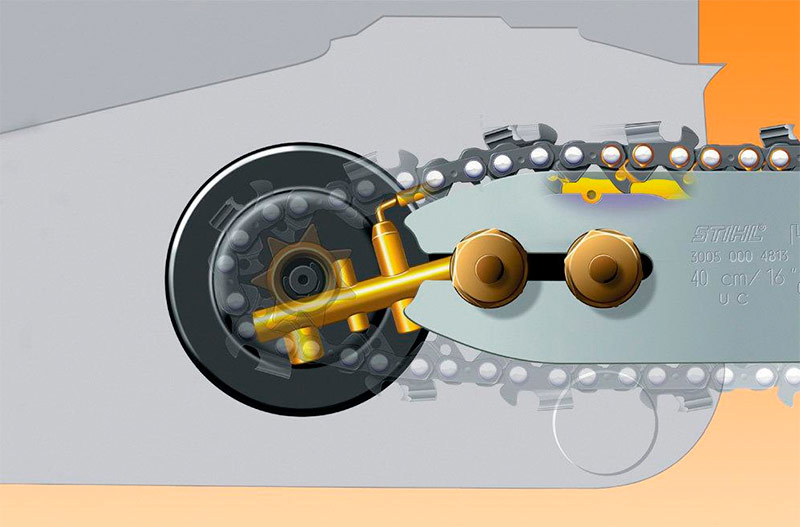
The main component of such a system is an oil pump. Pumps can be adjustable and unregulated. In adjustable pumps, it is possible to change the speed of oil supply to the tire, which is convenient functionality. Adjustable pumps are equipped with professional and semi-professional chainsaws.
Oil pumps can be made of plastic or metal. Metal pumps are more preferable because they are more durable, but they are more expensive.
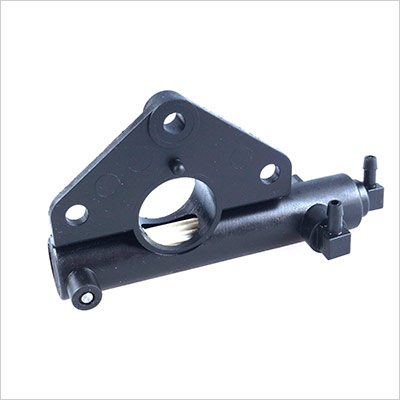
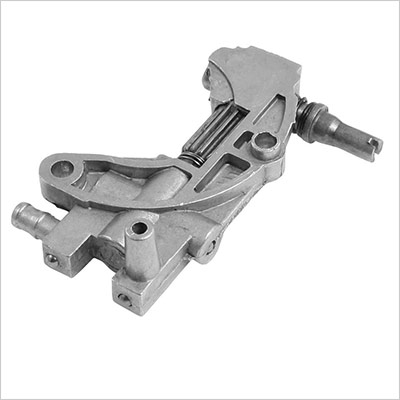
Headset selection
Having chosen a specific model of a chainsaw, you will most likely be forced to buy components from the same manufacturer. The fact is that the components of the saw set - the chain, the tire and the drive sprocket - are different from different manufacturers, but they differ, which means they are not interchangeable. The main differences between consumables from different manufacturers lie in the parameters of the drive sprocket and in the thickness of the chain link.
We also note that there must be a correspondence between the chain pitch and the parameters of the drive sprocket. Changing the chain to another, with a different step, you will have to replace the asterisk.
Additional functions
Anti-vibration system
Professional lumberjacks, who are forced to work with a chainsaw for 8 or more hours a day, very often suffer from joint diseases and circulatory disorders in their hands, which is a consequence of the constant exposure to sufficiently strong vibrations. To save users from this problem, almost all professional chainsaw models produced today are equipped with an anti-vibration system.
It is a damper separating the motor and the handle system. The damper smooths out vibrations from a running engine, as a result, vibration on the handles is felt to a lesser extent. The most persistent implementation option is protected against vibration - rubber shock absorbers between the body and the handles. Manufacturers achieve a reduction in vibration by clearly calibrating the ratio of the mass of the engine and the rest of the saw.
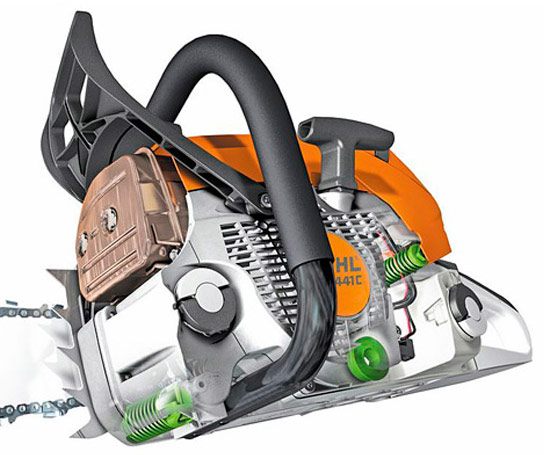
Such a function is useful not only for professional lumberjacks, but also for those who use a chainsaw for domestic purposes - when harvesting firewood, in private construction or when forming the crown of trees. When working with a saw equipped with an anti-vibration system, you will be less tired, it will be easier for you to hold and guide the saw.
Protective functions
A chainsaw is a potentially very traumatic tool. Of course, the safety of your life and health depends first of all on yourself, and more precisely on the careful observance by you of the rules for operating the tool. However, manufacturers are trying to do everything possible to minimize the risk of injury to users when working with a chainsaw.
Most often, troubles arise with the so-called back impact - when, as a result of contact of the front part of the working blade with a surface of increased hardness, the saw is sharply thrown back. The most reliable way to prevent injury to the user at this point is to instantly stop the circuit.
Two systems are used to block the circuit during a reverse impact. The first is a button mounted on the handle of the chainsaw, which must be held simultaneously with the trigger trigger. When a saw jumps sharply as a result of a back-strike, the sawyer reflexively releases this button, and as a result, the chain is blocked.
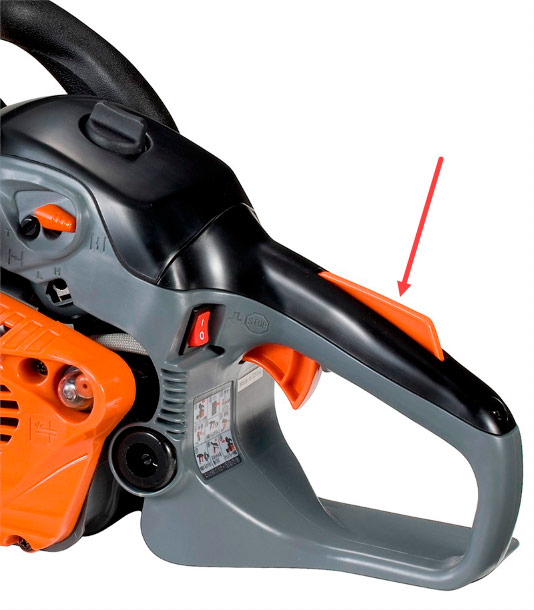
The second system is the installation of a special lever in front of the left hand of the operator. At the time of the return strike, the saw’s hand rests against this lever, which was put to the platoon before starting work: the lever is triggered - the chain stops.
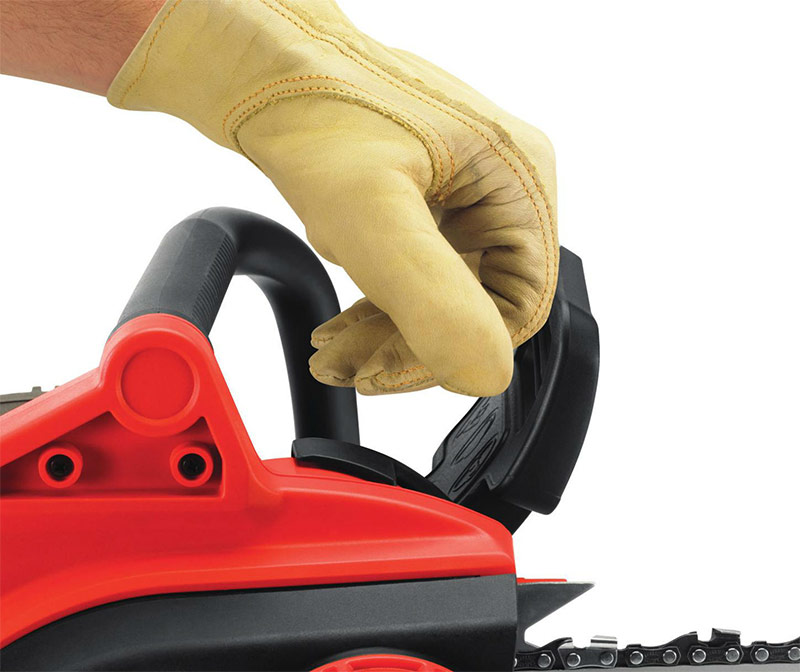
What you need to know about gasoline and oils used in the operation of chainsaws
Before you finally choose a chainsaw, you should get at least a general idea of how to feed this "beast". A two-stroke engine is installed on the chainsaws, which means that the tool is filled not with pure gasoline, but with a mixture of it with oil, and the ratio of components is strictly regulated by the manufacturer.
For domestic chainsaws, even the 76th gasoline is suitable (if you can find one today) and the cheapest oils for two-stroke motorcycle engines (the recommended ratio of oil to gasoline is 1:25). Imported models are more whimsical: for normal operation they require gasoline with an octane rating of at least 92 and branded “push-pull” oil (the recommended proportion, as a rule, is 1:40). In principle, on “bourgeois” saws, ordinary motorcycle oils are also applicable, but only if the engine speed per minute does not exceed 8.5 thousand, otherwise such a substitution will lead to a decrease in engine life.
You can store the prepared gasoline-oil mixture for no more than two to three months, but it is advisable to use it for two weeks. The fact is that gasoline in such a mixture, even if it is stored in a tightly closed container, is gradually oxidized. When using an “aged” mixture, the engine, as a rule, wears out faster. At the same time, professional chainsaws are more sensitive to the quality of the fuel mixture than household ones.
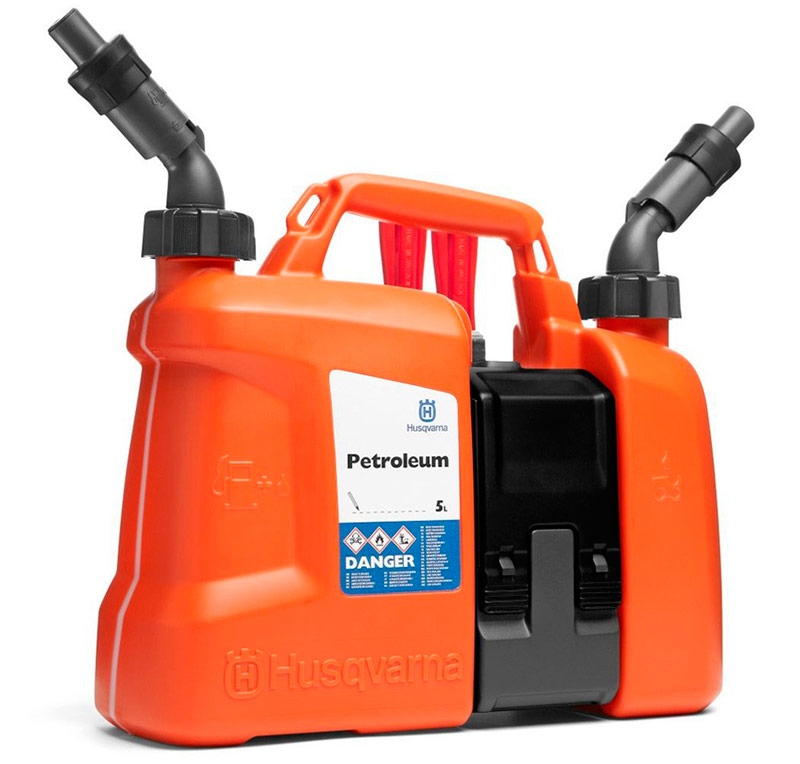
Chain oil is poured into a separate tank. Here you can easily do without expensive imported lubricants. But when choosing oil for the circuit, the ambient temperature should be taken into account. Mineral oils that perfectly perform their function in the summer period begin to crystallize in the cold. When working in the winter, it is better to use synthetic oils - they are less viscous and retain their properties at air temperatures up to –40 degrees.
Chainsaw manufacturers who have established themselves in the market
How to choose a chainsaw in terms of price and quality? Most of the domestic chainsaw market is divided between major European brands. Their products, due to their quality, are highly valued not only in Russia but throughout the world. The Asians, who are equally easily given the production of any equipment, are not far behind them.
Undoubtedly, you will not lose if you buy a chainsaw from Husqvarna, Stihl or Hyundai. But one should not neglect the products of companies offering budget models. Chainsaws they produce are sometimes less reliable, but they also find their customers thanks to more affordable prices, because choosing a tool based on the “better and more expensive” principle often turns out to be completely unjustified. How reasonable is the overpayment for reliability, efficiency, functionality and a well-known name on the nameplate - you decide. Ultimately, it largely depends on the tasks you are facing and the budget instrument allocated for the purchase.
Compare the products of the most popular brands in the domestic market and analyze the opinions of customers about these chainsaws.
Stihl

The recognized leader in the market of chainsaws today is the German company Stihl. Despite the already gained popularity, Stihl does not stop there and continues to improve its products. For example, a 2-MIX engine is installed on their chainsaws, characterized by a 20% reduction in fuel consumption and a 70% reduction in emissions.
The company produces chainsaws of all classes - household, semi-professional and professional; it also has a special line of saws designed for rescuers. With such a wide assortment, the wide range of prices is not surprising - from 17 thousand rubles for light household chainsaws to 50 thousand or more for powerful professional models. Stihl tools according to user reviews are very high quality. Recently, however, a huge number of fakes has appeared on the market, so you should carefully consider the choice of a reliable seller.
Husqvarna

The Swedish concern Husqvarna is the world's largest manufacturer of chainsaws and other tools for farmers and gardeners. Their products are presented on the market by household, semi-professional and professional chainsaws. The price range is from 15 to 30 or more thousand rubles, depending on the class of the instrument.
In general, Russian users are delighted with the quality of Husqvarna chainsaws, even the cheapest models collect a lot of positive reviews. The only thing that causes the dissatisfied murmur of users is the high cost of consumables and spare parts. However, the owners of all European-made chainsaws are facing a similar problem today.
Emak

Products of the Italian company Emak, which is the owner of the Efco and Oleo-Mac brands, are not very well known to Russian customers. Meanwhile, those who had the opportunity to work with Oleo-Mac saws were very pleased with this tool. The range of Emak has a lot of budget chainsaws, the price of which varies from 14 to 20 thousand rubles, as well as saws of the middle class.
Partner

Partner, which was born in the 1950s, was originally engaged in the production of professional equipment for loggers. After 30 years, she expanded her assortment, starting to produce tools for gardeners. Today Partner is part of the Swedish concern Husqvarna, but its market segment is very narrowed: Partner specializes exclusively in the production of low-cost models of household chainsaws.
The production is located in the Middle Kingdom, but this does not affect the quality of the products: for its price category (6-15 thousand rubles) it is very, very good, as evidenced by the reviews of the owners of Partner chainsaws.
Hyundai

The South Korean company Hyundai, known primarily for its cars, produces a whole range of agricultural tools, including chainsaws. Owners of Hyundai saws appreciate them for their high power and reliability of engines, as well as for a very affordable cost. However, we will be honest and note a number of shortcomings that Hyundai products are not without. The body of most models of chainsaws is made of plastic, which is not very practical, while even this did not help reduce the weight of the tool. Unsatisfied with potential buyers and extremely meager assortment of saws from this manufacturer.
These are not all the leaders of the domestic chainsaw market. The range of professional and amateur saws is so large today that everyone can find a tool for their liking and affordability. When visiting the store, be sure to pay attention to the products of German companies Huter, Dolmar and Al-ko, Japanese Makita and Kioritz Corporation (the latter owns brands such as Shindaiwa, Echo and KIORITZ,), the American Patriot’s, Chinese Champion and Carver. These chainsaws will undoubtedly be able to cope with all, even the most complex tasks assigned to them.

